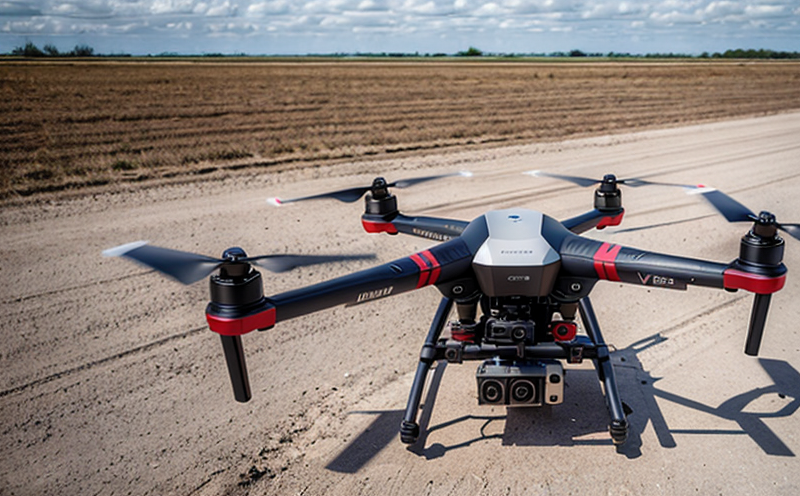ASTM F3003 UAV Maintenance and Continuing Airworthiness Testing
The ASTM F3003 standard provides a framework for maintaining and ensuring the continued airworthiness of unmanned aerial vehicle (UAV) systems. This standard is pivotal in the aerospace and aviation sectors, particularly as drone technology continues to evolve and expand into various applications.
ASTM F3003 outlines procedures and guidelines aimed at preventing UAVs from degrading beyond safe operational limits due to wear and tear or environmental factors. Compliance with this standard ensures that UAVs remain fit for purpose throughout their lifecycle, thereby enhancing safety in operations and reducing the risk of accidents.
The standard covers several aspects including initial inspection, periodic maintenance checks, and procedures for identifying when a UAV is no longer airworthy due to wear, damage, or obsolescence. It emphasizes the importance of continuous monitoring and documentation of the UAV's operational history, which includes flight time, environmental conditions encountered during operations, and any modifications made.
This testing protocol is critical in ensuring that UAVs meet stringent safety standards set by regulatory bodies like the Federal Aviation Administration (FAA) or the European Union Aviation Safety Agency (EASA). By adhering to ASTM F3003, operators can demonstrate their commitment to maintaining high safety standards and comply with international best practices.
The ASTM F3003 standard is particularly relevant for organizations operating drones in complex environments such as urban areas, remote locations, or critical infrastructure. The continuous airworthiness of these UAVs ensures that they remain reliable and safe, even under challenging conditions. This not only enhances operational efficiency but also builds trust with stakeholders who rely on the services provided by UAVs.
Given the increasing demand for autonomous systems in various industries such as agriculture, surveying, and security, ensuring the ongoing airworthiness of these drones is becoming more crucial than ever. ASTM F3003 provides a robust framework to help achieve this goal, making it an indispensable tool for quality managers, compliance officers, and R&D engineers working within the UAV industry.
Why It Matters
The importance of maintaining and ensuring continued airworthiness cannot be overstated in the context of UAV operations. The continuous evolution of drone technology necessitates stringent standards to ensure that these systems remain safe and reliable throughout their operational lifecycle.
- Enhanced Safety: Ensuring UAVs meet safety requirements helps prevent accidents, which is critical given the increasing number of drones in operation.
- Regulatory Compliance: Adherence to ASTM F3003 allows operators to comply with international standards set by regulatory bodies like FAA or EASA.
- Increased Reliability: Regular maintenance and inspection as per this standard ensure that UAVs remain reliable, even in challenging environments.
The continuous airworthiness of UAVs is particularly important for organizations operating drones in complex environments. By adhering to ASTM F3003, operators can demonstrate their commitment to maintaining high safety standards and comply with international best practices.
Why Choose This Test
- Comprehensive Coverage: ASTM F3003 provides a detailed framework for UAV maintenance that covers all aspects of the lifecycle, from initial inspection to periodic checks and final disposal.
- Regulatory Compliance: Compliance with this standard ensures adherence to international regulatory requirements, thereby reducing compliance risks.
- Enhanced Safety: By ensuring that UAVs meet stringent safety standards, operators can significantly reduce the risk of accidents.
- Improved Efficiency: Regular maintenance and inspection help identify potential issues early, preventing costly repairs or replacements.
The ASTM F3003 standard is particularly beneficial for organizations operating drones in complex environments. By adhering to this standard, operators can ensure that their UAVs remain reliable and safe, even under challenging conditions. This not only enhances operational efficiency but also builds trust with stakeholders who rely on the services provided by UAVs.
Competitive Advantage and Market Impact
The ASTM F3003 standard provides a significant competitive advantage in the UAV industry by offering a robust framework for maintaining and ensuring continued airworthiness. This standard allows operators to demonstrate their commitment to safety, reliability, and regulatory compliance, which is increasingly important as drones are integrated into more complex environments.
- Enhanced Reputation: Compliance with ASTM F3003 enhances the reputation of an organization by showcasing its commitment to maintaining high standards in UAV operations.
- Increased Market Share: By ensuring that UAVs meet stringent safety and reliability requirements, operators can attract more customers and increase their market share.
- Reduced Risks: Compliance with this standard reduces the risk of accidents, thereby improving operational safety and reducing potential liabilities.
The ASTM F3003 standard is particularly beneficial for organizations operating drones in complex environments. By adhering to this standard, operators can ensure that their UAVs remain reliable and safe, even under challenging conditions. This not only enhances operational efficiency but also builds trust with stakeholders who rely on the services provided by UAVs.





